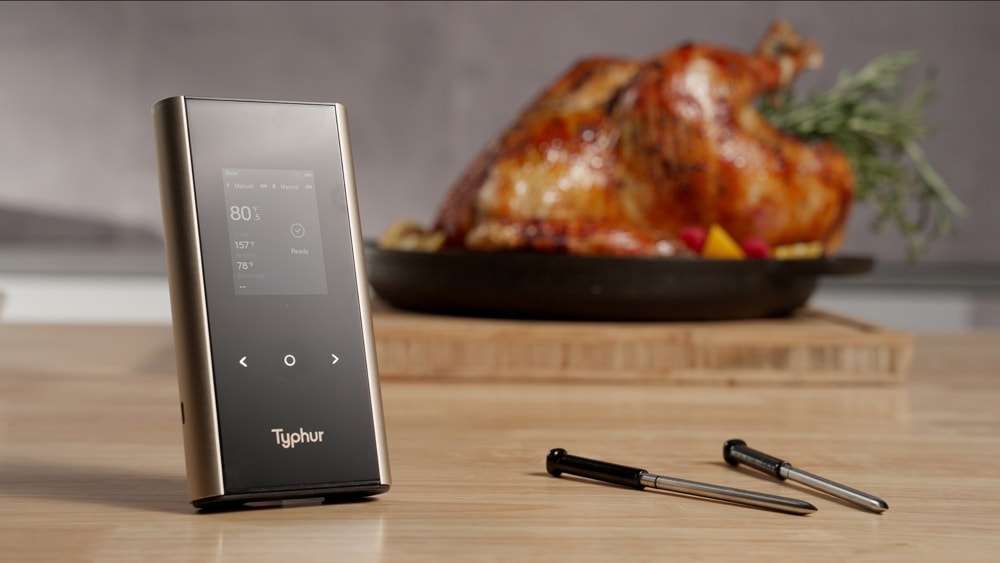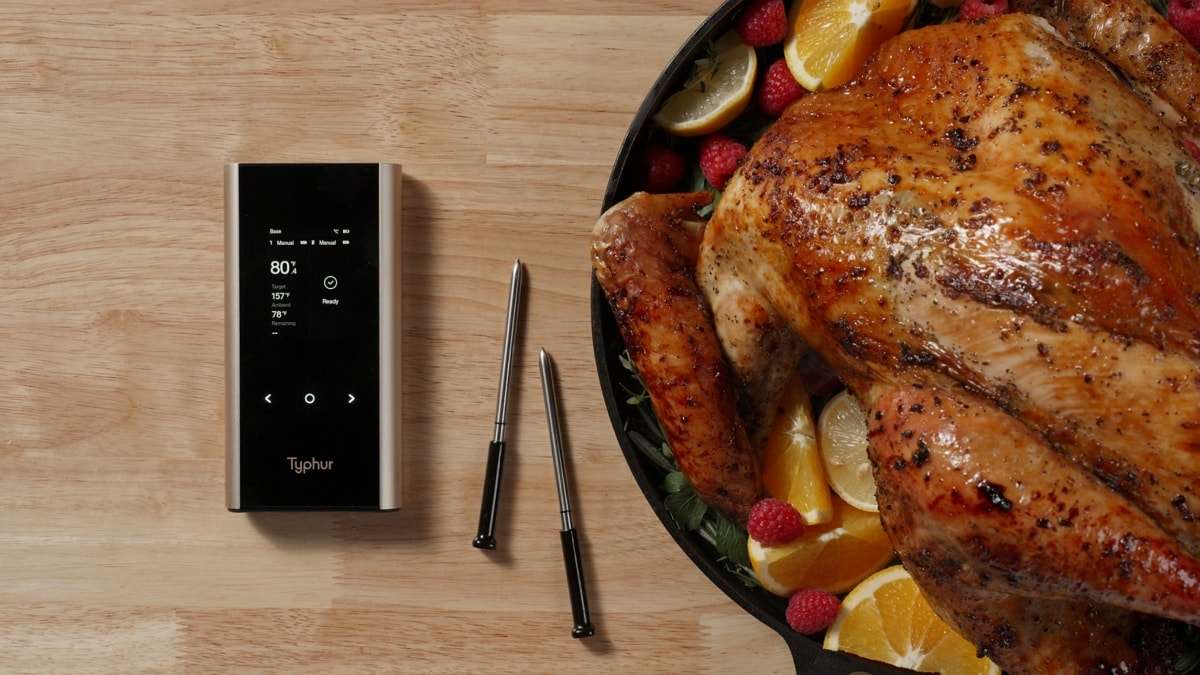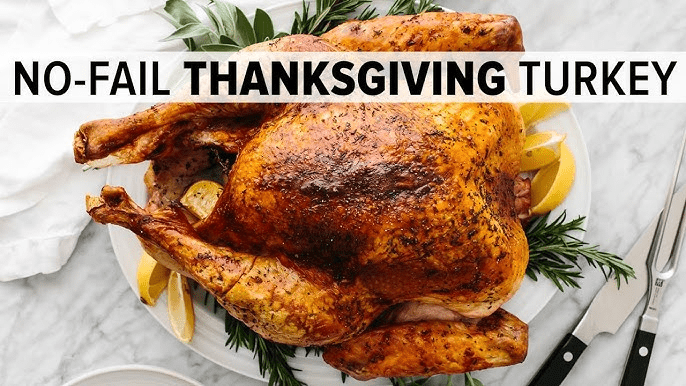Thanksgiving is synonymous with good food, warm gatherings, and, of course, the perfectly roasted turkey. The turkey is the star of the Thanksgiving table, and achieving that golden, tender, and flavorful bird is an art form that can be mastered with the right recipe, techniques, and tools.
Here’s a step-by-step guide to the best turkey recipe that will leave your guests raving.
Thanksgiving Turkey Temperature Guide
The secret to a juicy, flavorful turkey lies in monitoring the right internal temperature. So, grab the best thermometer for turkey (trust me, it’ll be your best friend on Turkey Day), and let’s break down the perfect turkey cooking temperatures.
The key to a perfectly cooked turkey is hitting the right internal temperatures for both the light meat (breast) and the dark meat (thighs and legs). Here are the ideal internal temperatures for turkey:
- Light Meat (Breast): 165°F (74°C)
This ensures the breast meat stays juicy and tender without drying out. Be careful not to let it climb too high—it’ll go from moist to dry in a flash.
- Dark Meat (Thighs and Legs): 175°F to 180°F (79°C to 82°C)
Dark meat shines when cooked to a slightly higher temperature. This allows the fat and connective tissue to melt, resulting in that juicy, pull-apart tenderness everyone loves.
Tips: A smart wireless thermometer like the Typhur Sync Gold is essential for accuracy.
Ingredients For The Perfect Thanksgiving Turkey
Before diving into the preparation, having a well-organized list of ingredients is key. For this recipe, you’ll need:
- 1 whole turkey (12-14 lbs), thawed if frozen
- 1 cup of unsalted butter, softened
- Fresh herbs: rosemary, thyme, and sage
- 1 lemon, quartered
- 1 head of garlic, halved crosswise
- Salt and black pepper to taste
- 2 onions, peeled and quartered
- 2 carrots, peeled and cut into large chunks
- 2 celery stalks, cut into large pieces
- 4 cups of chicken or turkey broth
Preparation Steps
1. Prepare The Turkey
Start by preheating your oven to 325°F (165°C). Remove the giblets and neck from the turkey cavity and pat the bird dry with paper towels. Drying the turkey thoroughly ensures a crispy skin once roasted.
2. Season And Stuff The Turkey
Generously season the inside of the turkey cavity with salt and black pepper. Stuff the cavity with the lemon quarters, halved garlic head, and a few sprigs of fresh herbs. This simple step infuses the turkey with fragrant flavors that will permeate the meat as it cooks.
3. Prepare The Herb Butter
In a bowl, mix the softened butter with finely chopped rosemary, thyme, and sage. This herb butter will help keep the meat moist and flavorful. Gently separate the skin from the breast of the turkey and spread a generous amount of the herb butter under the skin and all over the outside.
4. Add Vegetables And Broth
Place the onions, carrots, and celery in the bottom of a large roasting pan to create a flavorful base for the turkey and drippings. Pour about 2 cups of the chicken or turkey broth into the pan. This helps keep the turkey moist during the initial phase of cooking and contributes to a rich, savory gravy later.
5. Use The Best Thermometer For Turkey
The key to cooking a turkey that’s both safe to eat and perfectly juicy is using a turkey thermometer. Insert the thermometer into the thickest part of the thigh without touching the bone. This ensures that you’ll get an accurate reading, which is essential for achieving that perfect balance of doneness without drying out the meat.

Cooking The Turkey
1. Start Roasting
Place the turkey in the preheated oven and let it roast uncovered. Every 45 minutes, baste the turkey with the pan drippings or an additional brush of the herb butter to maintain a moist and flavorful exterior. If the skin begins to darken too quickly, cover the turkey loosely with aluminum foil.
2. Monitor The Temperature
A good rule of thumb is to roast the turkey for about 15 minutes per pound. However, ovens vary, and relying solely on time can lead to an over- or undercooked bird. The best thermometer for turkey will be your guide here. When the internal temperature in the thickest part of the thigh reaches 165°F (74°C), the turkey is safe to eat and ready to be removed from the oven.
3. Resting The Turkey
Remove the turkey from the oven and let it rest for at least 20-30 minutes before carving. This step allows the juices to redistribute throughout the meat, ensuring a moist and tender result. Use your thermometer for turkey to confirm that the temperature has not dropped below safe levels during resting.

The Best Thanksgiving Turkey
Ingredients
- 1 Turkey (12-14 lbs whole turkey, thawed if frozen)
- 1 cup Unsalted Butter (softened)
- Fresh Herbs (rosemary,thyme, and sage)
- 1 Lemon (quartered)
- 1 Garlic (1 head halved crosswise)
- Salt (to taste)
- Black Pepper (to taste)
- 2 Onions (peeled and quartered)
- 2 Carrots (peeled and cut into large chunks)
- 2 Celery (cut into large pieces)
- 4 cups Chicken Broth (Or Turkey Broth. I prefer the flavor of chicken broth (Crystal M.))
Instructions
Preparation Steps
Prepare The Turkey
- Start by preheating your oven to 325°F (165°C). Remove the giblets and neck from the turkey cavity and pat the bird dry with paper towels. Drying the turkey thoroughly ensures a crispy skin once roasted.
Season And Stuff The Turkey
- Generously season the inside of the turkey cavity with salt and black pepper. Stuff the cavity with the lemon quarters, halved garlic head, and a few sprigs of fresh herbs. This simple step infuses the turkey with fragrant flavors that will permeate the meat as it cooks.
Prepare The Herb Butter.
- In a bowl, mix the softened butter with finely chopped rosemary, thyme, and sage. This herb butter will help keep the meat moist and flavorful. Gently separate the skin from the breast of the turkey and spread a generous amount of the herb butter under the skin and all over the outside.
Add Vegetables And Broth
- Place the onions, carrots, and celery in the bottom of a large roasting pan to create a flavorful base for the turkey and drippings. Pour about 2 cups of the chicken or turkey broth into the pan. This helps keep the turkey moist during the initial phase of cooking and contributes to a rich, savory gravy later.
Cooking The Turkey
Start Roasting
- Place the turkey in the preheated oven and let it roast uncovered. Every 45 minutes, baste the turkey with the pan drippings or an additional brush of the herb butter to maintain a moist and flavorful exterior. If the skin begins to darken too quickly, cover the turkey loosely with aluminum foil.
Monitor The Temperature
- A good rule of thumb is to roast the turkey for about 15 minutes per pound. However, ovens vary, and relying solely on time can lead to an over- or undercooked bird. The best thermometer for turkey will be your guide here. When the internal temperature in the thickest part of the thigh reaches 165°F (74°C), the turkey is safe to eat and ready to be removed from the oven.
Resting The Turkey
- Remove the turkey from the oven and let it rest for at least 20-30 minutes before carving. This step allows the juices to redistribute throughout the meat, ensuring a moist and tender result. Use your thermometer for turkey to confirm that the temperature has not dropped below safe levels during resting.
Carving And Serving Tips
- Carving a turkey can be daunting, but with a few simple tips, you can present your guests with beautifully sliced portions. Start by removing the legs and thighs, followed by the wings. Then, slice the breast meat against the grain for maximum tenderness. Arrange the slices on a warm platter and garnish with fresh herbs for an elegant touch.
Gravy Enhancement
- Don’t forget about the drippings in the roasting pan! Strain them and use them as a base for a rich, homemade gravy. Combine the drippings with flour and additional broth, whisking continuously over medium heat until the gravy reaches your desired thickness. Season to taste with salt and pepper.
Notes
Carving And Serving Tips
Carving a turkey can be daunting, but with a few simple tips, you can present your guests with beautifully sliced portions. Start by removing the legs and thighs, followed by the wings. Then, slice the breast meat against the grain for maximum tenderness. Arrange the slices on a warm platter and garnish with fresh herbs for an elegant touch.
Gravy Enhancement
Don’t forget about the drippings in the roasting pan! Strain them and use them as a base for a rich, homemade gravy. Combine the drippings with flour and additional broth, whisking continuously over medium heat until the gravy reaches your desired thickness. Season to taste with salt and pepper.
Why The Right Thermometer Matters
Choosing the best thermometer for turkey is not just about convenience—it’s about safety and ensuring the best culinary outcome. A thermometer that provides quick, accurate readings ensures that your turkey reaches the ideal internal temperature without overcooking. Overcooked turkey can become dry and tough, while undercooked turkey poses health risks.
Benefits Of Using A Reliable Thermometer:
- Precision: Guarantees that the turkey is cooked to the right temperature for safe consumption.
- Juiciness: Helps prevent overcooking, which can result in dry meat.
- Peace of Mind: Allows you to step away from the kitchen with confidence, knowing you’ll be alerted when the turkey is perfectly done.
For more details on choosing the best tool for your Thanksgiving preparations, consider exploring resources like this guide.
Additional Tips For A Memorable Thanksgiving Meal
1. Plan Ahead
Preparation is key. Make sure you have all your ingredients, tools, and a game plan ready before Thanksgiving Day to minimize stress.
2. Keep Side Dishes Simple
Focus on classic sides like mashed potatoes, cranberry sauce, and green bean casserole. These pair beautifully with turkey and can be made in advance to save time.
3. Include A Mix Of Traditional And New Dishes
While everyone loves the classics, adding one or two new dishes to the menu can make the meal more exciting and memorable for guests.
Final Thoughts
A perfectly cooked turkey is the highlight of any Thanksgiving meal, and achieving this is easier with the right preparation, ingredients, and tools. Using the best thermometer for turkey ensures that your centerpiece is not only safe to eat but also tender and full of flavor. This Thanksgiving, impress your guests with a turkey that’s golden, juicy, and cooked to perfection. Enjoy the day, share stories, and create memories around a table filled with delicious, lovingly prepared food.
Here’s more Thanksgiving posts you may enjoy. I hope they help with your hosting this year!
- Download This Free Easy Printable Thanksgiving Shopping List
- Check Out These Funny Thanksgiving T-Shirts!
- Get Thanksgiving Ready With This Fall Room Spray Recipe!
- Enjoy This Pumpkin Ginger Trifle Recipe This Fall!
- 5 Ways To Ease Thanksgiving Stress
- Perfect Wines For Fall
- Printable Autumn Bunting
Travel Lover | Pet Mama | Beauty Junkie | Low Glycemic – Healthy Fats – Low Carb – Keto Inspired Food Enthusiast | Cocktails | Printables
I am a stay-at-home- mom, living in KY with my husband and children. I’m a travel and lifestyle blogger encouraging folks to live their life one adventure at a time while also focusing on beauty, essential oils and health. From time to time I also like to showcase my adorable pets along with my family. Along with Cinnamon Hollow I can be found at The Martin Family Adventure … read more










